
Photo credit: Rachel Smith
Nesting season officially kicked off on May 1st in Florida, where about 90% of sea turtle nesting in the U.S. takes place. Whether you are a Florida resident or are simply stopping by for summer vacation, this information will help you get the most out of our beautiful beaches while also being considerate of nesting sea turtles and hatchlings. Share this information with your beach-loving family and friends to ensure that our beaches can be safely and responsibly enjoyed by all!
Human threats that can interfere with the nesting and hatching process include:
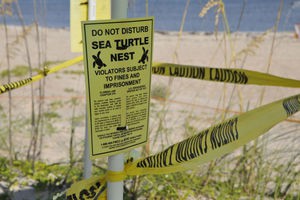 Sandcastles: knock them down! The flatter the beaches are, the easier it will be for nesting sea turtles and hatchlings to safely make it to and from the water. We know you worked very hard on your masterpiece and are sorry to see it go, but the turtles appreciate it.
Sandcastles: knock them down! The flatter the beaches are, the easier it will be for nesting sea turtles and hatchlings to safely make it to and from the water. We know you worked very hard on your masterpiece and are sorry to see it go, but the turtles appreciate it.Want a chance to see a nesting loggerhead sea turtle? Attend a Turtle Walk! STC’s Turtle Walks take place in the Archie Carr National Wildlife Refuge, starting at the Barrier Island Center in Melbourne Beach, FL. Participants have the chance to witness a nesting loggerhead sea turtle. Walks are conducted by STC on Monday, Tuesday, Thursday, and Friday nights in June and July. Space is limited to 20 people per night. Cost is $15 per person. Click here to reserve your spot!
Are you planning to upgrade your phone and don’t know what to do with your old one? Or maybe you have a drawer full of old cell phones and electronics collecting dust? Great news… You can recycle your old devices and raise money for sea turtles at the same time with SecondWave Recycling!
 SecondWave Recycling partners with non-profits to fundraise by recycling cell phones, tablets and iPods! SecondWave will donate 100% of the wholesale value of the device to STC. This program also keeps phones out of landfills, which prevents harmful toxins from potentially seeping into waterways. The materials that go into these devices also have more than just one life and can be used for new technology!
SecondWave Recycling partners with non-profits to fundraise by recycling cell phones, tablets and iPods! SecondWave will donate 100% of the wholesale value of the device to STC. This program also keeps phones out of landfills, which prevents harmful toxins from potentially seeping into waterways. The materials that go into these devices also have more than just one life and can be used for new technology!
Since partnering with SecondWave in 2014, STC supporters have helped recycle over 800 phones and earned $1,035 in donations for sea turtles!
 Sending in your phone is quick, easy, and FREE if you send in 4 or more phones at once! To donate your cell phone, all you have to do is visit www.secondwaverecycling.com/, click Donate Your Phone, choose Sea Turtle Conservancy as your Charity and print out your mailing label. Or if you are planning to send in multiple devices, you can click here to get a FREE FedEx shipping label!
Sending in your phone is quick, easy, and FREE if you send in 4 or more phones at once! To donate your cell phone, all you have to do is visit www.secondwaverecycling.com/, click Donate Your Phone, choose Sea Turtle Conservancy as your Charity and print out your mailing label. Or if you are planning to send in multiple devices, you can click here to get a FREE FedEx shipping label!
**NOTE – Free shipping labels can only be provided for US-based shipments. For international shipments, please use your local postal carrier and ship to the SecondWave Recycling Office.**
Besides helping sea turtles, here are a few other reasons why you should donate your old phone:
 The mining of metals for cell phones and other electronics is the #1 cause of toxic pollution in the United States.
The mining of metals for cell phones and other electronics is the #1 cause of toxic pollution in the United States.
One million cell phones contain 33 pounds of palladium, 75 pounds of gold, 772 pounds of silver and 35,274 pounds of copper. These resources can be recovered and used to make new cell phones.

Cell phones contain toxic materials such as Arsenic, Antimony, Beryllium, Cadmium, Copper, Lead, Nickel and Zinc. If these materials are not properly disposed of they can contaminate air, soil and groundwater. The Cadmium from a single cell phone is capable of polluting 158,200 gallons of water.

If we recycled every cell phone discarded in the United States annually we would save enough energy to power more than 24,000 homes for a year. Recycling just one cell phone saves enough energy to power a laptop for 44 hours!
Questions about our SecondWave Recycling campaign? Email lexie@conserveturtles.org
Sea Turtle Conservancy (STC) announces a change in the scientific oversight of its international sea turtle research and monitoring programs. Effective in July, the position of Scientific Director will transition from Dr. Emma Harrison to Dr. Roldán Valverde. Anyone interested in collaborating with STC on research projects in Costa Rica, Panama and other international sites are encouraged to reach out directly to Dr. Valverde at roldan@conserveturtles.org. Likewise, anyone interested in exploring opportunities to serve as a Research Assistant with the Tortuguero program or at STC’s project sites in Panama can now direct those inquires to Roldán.

Dr. Harrison with nesting turtle
While STC is very excited about what Dr. Valverde will bring to this position, the organization is equally sad to announce the departure of Dr. Emma Harrison, who has resigned to explore new opportunities in the field of biological conservation. Dr. Harrison has worked with STC off and on since 1998 and has served as Scientific Director since 2006. Through her leadership and passion, Dr. Harrison continued a long tradition of outstanding scientific oversight of STC’s sea turtle monitoring programs; she trained and inspired countless research assistants and helped expand STC’s education and community outreach programs in both Costa Rica and Panama. Emma will be greatly missed by STC, though she will forever remain a part of the STC family and the history of the organization.
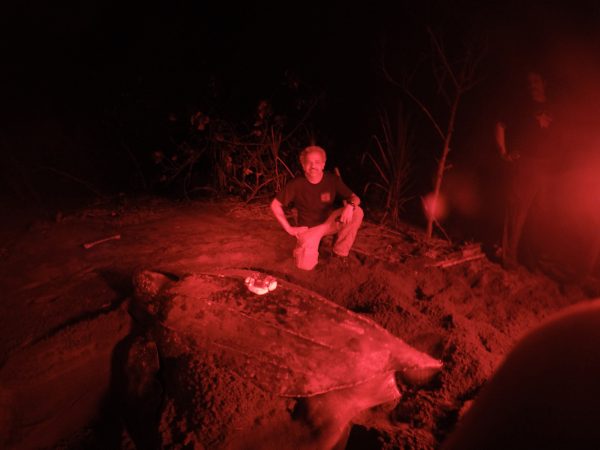
New STC scientific director Dr. Valverde with tagged leatherback
As STC’s incoming Scientific Director, Dr. Valverde will provide scientific oversight of STC’s various sea turtle research programs, particularly the long-term projects in Tortuguero, Costa Rica, and Bocas del Toro, Panama. Over two decades ago, as a young Costa Rican biologist, Roldán served as Research Coordinator of STC’s Tortuguero research program. Since that time, he has achieved international recognition in the field of sea turtle research and is a leading expert in the area of sea turtle physiology. Dr. Valverde served recently as President of the International Sea Turtle Society; he is well published; and he currently serves as a graduate biology professor at Southeast Louisiana University in New Orleans. As a native Costa Rican and an accomplished scientist and educator, Roldán will be in an ideal position to continue elevating the science and the effectiveness of STC’s many research and conservation programs. He also will help STC expand its efforts to cultivate and train young biologists from throughout Latin America and the Caribbean. Dr. Valverde’s position with STC is endowed by the Emily T. Clay Scientific Director’s Endowment.
The 11th annual Endangered Species Day is May 20th, 2016! Endangered Species Day was created by Congress in an effort to raise awareness of the many endangered, threatened, and at risk species and the critical role they play in their environments.
Many zoos, parks, wildlife refuges, museums, schools and community centers, among other participants, will host educational events to promote and celebrate Endangered Species Day and the reasons behind its creation. To find an event near you, visit http://www.endangered.org/campaigns/endangered-species-day/

Endangered Species Day raises awareness about the many endangered species we have in our own communities. For example, did you know Florida has more endangered species than any other Atlantic state? Population growth coupled with habitat loss, tourism, and pollution are just a few factors that have imperiled many species in our state. In addition, Endangered Species Day is also a great time to celebrate success stories, like the recovery of the green turtle, the alligator, and the bald eagle.Thanks to the significant strides we have made under the Endangered Species Act, we are celebrating more and more success stories with each passing year.
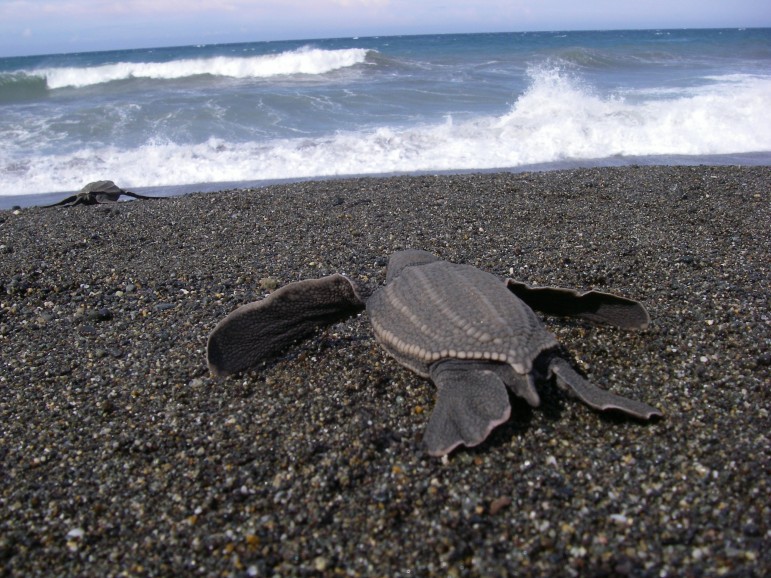
Photo retrieved from Endangered Species Coalition
For decades all sea turtles in U.S. waters have been listed under the Endangered Species Act, which was created in 1973.They are protected by the NOAA Fisheries in the ocean and by the U.S. Fish and Wildlife Service (USFWS) in their beach nesting habitats along U.S. coasts. In the United States threats to sea turtles include habitat loss, pollution and disease, boat strikes, entanglement in marine debris and accidental capture in fisheries. However, unlike other species of sea turtles, green turtles interact less with fisheries, which has contributed significantly to their recovery and made them an Endangered Species Act success story. During the nesting season of 1990, fewer than 50 green sea turtles were documented at the Archie Carr National Wildlife Refuge on Florida’s east coast. By 2005, there were just over 3,000 nests. In the most recent nesting season of 2015, green sea turtles set a new record with 14,152 nests! This comeback makes green turtles one of the greatest conservation success stories of our time. The species’ success can be attributed to the Endangered Species Act, STC and all other supporters who worked tirelessly to give green turtles a fighting chance.

Green Sea Turtle by Julie Suess
Sea turtles are not the only species that have had huge success stories thanks to the Endangered Species Act. Many species you may encounter on a regular basis in Florida were once on the brink of extinction. In the 1950s, the American alligator had nearly been hunted to extinction, but thanks to habitat protections and strong hunting regulations, their population from North Carolina to Texas has increased to about 5 million. The brown pelican was dramatically impacted by loss of habitat, but under the Endangered Species Act, they have made a strong comeback, and were officially removed from the endangered species list in 2009. Our national bird, the bald eagle, numbered in the hundreds in the 1960s, but with protection and the elimination of the pesticide DDT, which made eggs to fragile to hatch, its numbers have soared to over 14,000 breeding pairs today. The Endangered Species Act protects 1,357 species of animals (694 U.S. species) and 901 species of plants (898 U.S. species), and has prevented their extinction, which in turn helps to maintain healthy and sustainable ecosystems and a healthy planet.
On Endangered Species Day celebrate the Act’s successes and keep the momentum going!
1. Learn about endangered species
The best way to protect endangered species is learning about them and why they’re important. So teach yourself and educate those around you about the value of endangered species and why they are worth saving in their own right. STC’s educational program empowers sea turtle groups throughout Florida, provides educational materials and uses the concept of sea turtle migration tracking as an online educational tool. Learn more about endangered species by visiting the official site of the US Fish and Wildlife Service at www.fws.gov/endangered
 2. Visit a national wildlife refuge, park or other open space
2. Visit a national wildlife refuge, park or other open space
These places are home to a lot of different species, and preserving an endangered species’ habitat is essential to protecting the species. You can help by visiting a refuge close to where you live and become a volunteer. The Archie Carr National Wildlife Refuge in Florida is a major safe haven for sea turtles. About 25 % of Florida’s sea turtle nesting occurs in the Refuge.
3. Make your home wildlife friendly
Secure garbage in shelters or cans with locking lids and feed pets indoors to avoid attracting wild animals to your home. Taking these actions can keep animals like raccoons, which are sea turtle predators, away. Reduce your use of water in your home and garden so animals that live in or near water can have a better chance of survival. If you live on the beach you can make your home sea turtle friendly by implementing sea turtle lighting.
4. Plant native plants
Native plants provide food and shelter for native animals. You can plant sea oats on the beach to help prevent dune erosion and provide habitat for sea turtle nesting. STC conducts native dune vegetation planting to provide an additional buffer to reduce or eliminate unwanted light on the beach and to enhance nesting habitat at various project sites in the Florida panhandle.
5. Stay away from herbicides and pesticides
Herbicides and pesticides may keep yards looking nice, but they are in fact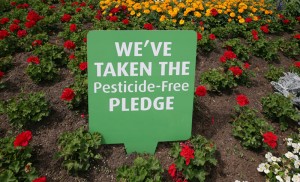 hazardous pollutants that affect wildlife at many levels. Many herbicides and pesticides take a long time to degrade and build up in soil and throughout the food chain. For alternatives to pesticides, visit http://www.beyondpesticides.org.
hazardous pollutants that affect wildlife at many levels. Many herbicides and pesticides take a long time to degrade and build up in soil and throughout the food chain. For alternatives to pesticides, visit http://www.beyondpesticides.org.
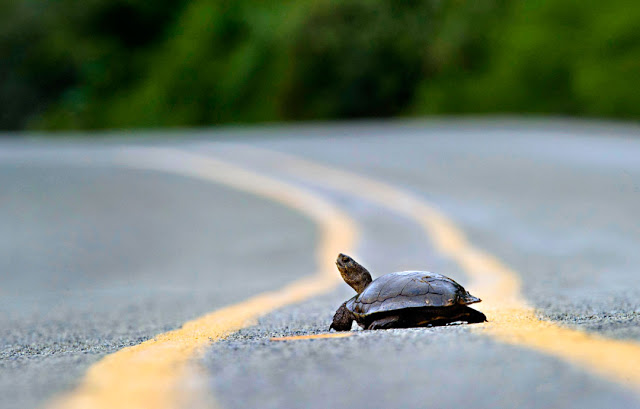
Photo by Robin Loznak
6. Slow down when driving
One of the main obstacles for wildlife in developed areas is roads. Animals that live in developed areas navigate in areas full of human hazards and roads present wildlife with a dangerous threat. So when you’re driving, slow down and be on the lookout for wildlife. You should also apply these practices while boating to avoid harming sea turtles and other endangered species in the water.
7. Recycle and buy sustainable products
Recycle anything that can be recycled and buy sustainable products as a simple gift to nature and its species. We love reusable glass straws from Strawesome and snack bags from LunchSkins!
8. Never purchase products made from threatened or endangered species
Overseas trips can be exciting and fun, and everyone wants a souvenir. But sometimes the souvenirs are made from species nearing extinction. Avoid supporting the market for illegal wildlife products such as tortoise-shell, ivory and coral. Hawksbill sea turtle shells are often used to be made into sunglasses, jewelry and other trinkets because of their beautiful shell pattern.
9. Stand up for wildlife
Harassing wildlife is cruel and illegal. Harmful behavior such as disturbing and distracting sea turtles is illegal and can be reported by calling any of the numbers listed on our website.
10. Protect wildlife habitat
Perhaps the greatest threat that faces many species is the widespread destruction of habitat. Environmental issues such as oil and gas drilling and development result in habitat destruction. Habitats belonging to endangered species should be protected so the impact on endangered species is minimized.
Any effort to help an endangered species is appreciated, so participate and celebrate national Endangered Species Day on May 20th, 2016!
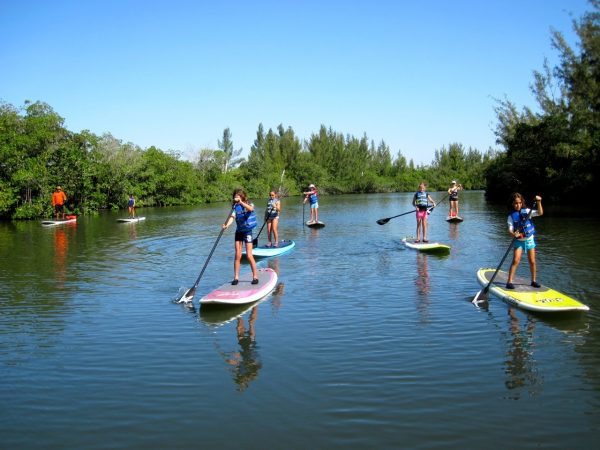
The Barrier Island Center, nestled in the heart of the Archie Carr National Wildlife Refuge in Melbourne Beach, Florida, is bringing back the Eco-Explorers Summer Camps program in 2016. The camps run throughout the month of June and are offered to children ages 9 to 15.

Participants will enjoy unforgettable experiences, from snorkeling to explore life below the ocean surface and kayaking and paddle boarding to observe first-hand the diversity of life on the Indian River Lagoon, to surfing to further connect with the very beach that attracts more nesting sea turtles than virtually any place on Earth.
Camp dates:
 Each session offered will cost $325 and includes transportation, certified aquatic instructors, equipment, t-shirt, a year-long Sea Turtle Conservancy honorary e-membership and a complimentary guided sea turtle walk with preferred reservation! To enroll, complete and fax THIS FORM to 321-952-3207. You may then call 321-723-3556 to make your payment. For more information, visit our website. Enrollment is limited to 13 per week and spots fill up quickly! For questions, please email donnalee@conserveturtles.org We hope to see you there!
Each session offered will cost $325 and includes transportation, certified aquatic instructors, equipment, t-shirt, a year-long Sea Turtle Conservancy honorary e-membership and a complimentary guided sea turtle walk with preferred reservation! To enroll, complete and fax THIS FORM to 321-952-3207. You may then call 321-723-3556 to make your payment. For more information, visit our website. Enrollment is limited to 13 per week and spots fill up quickly! For questions, please email donnalee@conserveturtles.org We hope to see you there!

Join Sea Turtle Conservancy for the second annual Cuba Sea Turtle Expedition! STC is partnering with the Cuba Marine Research and Conservation Program, The Ocean Foundation and Holbrook Travel to offer a Sea Turtle and Cultural Expedition to Cuba from June 25th – July 3rd, 2016.

Participants will visit Havana, the Guanahacabibes Peninsula and Vinales over the course of the expedition. CLICK HERE FOR THE FULL ITINERARY
Participants will have the opportunity to look for turtles coming ashore on the beaches of the Guanahacabibes Peninsula and observe the nesting process.
The group will return to a turtle nesting beach the following day to document any tracks from the previous night.
Hours later, participants will return to the turtle beach where they will have the opportunity to help the researchers measure the turtles and record data.

Participants will also enjoy activities such as a walking tour of Old Havana, a visit to the National Museum of  Natural History, a visit to the Alamar Organoponic Gardens and leisure time.
Natural History, a visit to the Alamar Organoponic Gardens and leisure time.
The beaches of the Guanahacabibes National Park are home to the second largest breeding population of green sea turtles in Cuba with an average of more than 300 nests per season.
2013 was a record year for the park’s beaches with nearly 900 nests recorded!
Through the efforts of University of Havana’s Center for Marine Investigations, an estimated 14,000 hatchlings were saved. You will get to participate directly in this successful Cuban conservation program, with a portion of your trip fees going directly to support this ongoing work.
Watch below to see STCs Cuba expedition from last year:
Cost includes gratuities, Miami/Tampa hotel and donations to the Cuban Society for the Protection of the Environment and Sea Turtle Conservancy.
Cost does not include international airfare estimated at $575 from Miami or Tampa (estimate includes visa fee).
The Sea Turtle Grants Program (STGP), funded by the sale of Florida’s Helping Sea Turtles Survive specialty license plate, recently awarded $311,649.72 to 24 different projects benefiting Florida sea turtles as part of the 2016-2017 grant funding cycle.

Each year, the Sea Turtle Grants Program distributes money to coastal county governments, educational and research institutions and nonprofit groups through a competitive application process. The sea turtle specialty license plate is also the primary source of funding for the Florida Fish and Wildlife Conservation Commission’s Marine Turtle Protection Program.
The following organizations received grants for their approved projects for the 2016-2017 cycle:
The sea turtle plate is the number two overall selling specialty tag in Florida, and the number one environmental specialty plate. By purchasing the sea turtle specialty license plate, Floridians are voluntarily funding important programs to save endangered sea turtles and their habitats.
To learn more about the Sea Turtle Grants Program and the “Helping Sea Turtles Survive” specialty license plate, please visit www.helpingseaturtles.org.
**UPDATE: CONTEST IS NOW CLOSED! WINNER WILL BE ANNOUNCED LATER THIS MONTH!**
July 2016 marks the 10th anniversary of Sea Turtle Conservancy’s Sea Turtle Weekend at the Four Seasons Resort Nevis, West Indies. To celebrate, STC and the Four Seasons are welcoming turtle lovers to join the Sea Turtle Art Contest!

July 2015 Nevis Tour de Turtles release
For a chance to win a three-night stay at the Resort, artists and conservationists are invited to submit an original artistic design depicting sea turtles through the Resort’s Facebook page.

Photo credit: Four Seasons Resort Nevis, West Indies
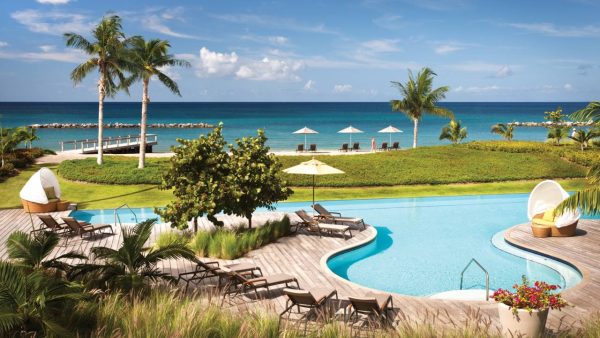
Photo credit: Four Seasons Resort Nevis, West Indies
One design will be selected based on creativity, turtle imagery and simplicity, and the winner, along with a guest, will be flown to Nevis to partake in Four Seasons Resort Nevis’ Sea Turtle Weekend, July 15-18, 2016. Along with a weekend-long, sea turtle-themed program, you also will help scientists track, catch, tag and release these majestic creatures. The winning design will also be placed on T-shirts, and all profits will go to the Sea Turtle Conservancy to continue to raise awareness for the protection and education of sea turtles.

July 2012 Nevis Tour de Turtles release
The deadline to enter is March 31st. Entries will be judged on creativity, turtle imagery, and simplicity. For more details, and to enter, use this link: http://shout.lt/bsNMd
For questions about the contest, please email lexie@conserveturtles.org
**UPDATE: CONTEST IS NOW CLOSED! WINNER WILL BE ANNOUNCED LATER THIS MONTH!**
Since 1959, STC has been conducting conservation programs in Tortuguero, Costa Rica. Tortuguero is one of the most important sea turtle nesting sites in the world. This means that vital sea turtle nesting research is conducted by our staff in Tortuguero. However, the staff housing building, the Kontiki, could no longer withstand the harsh climate.
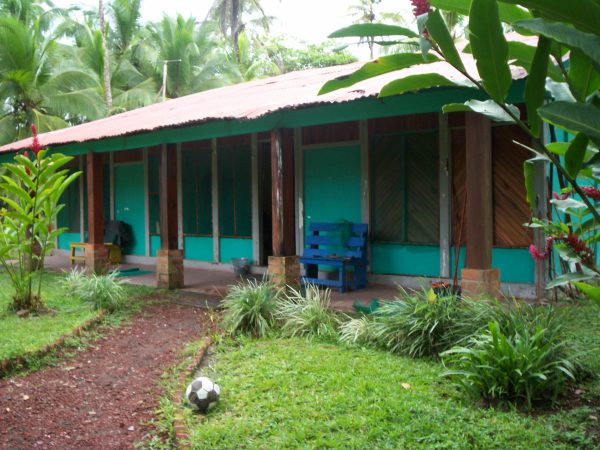
The Kontiki before renovations
For Giving Tuesday 2014 and World Sea Turtle Day 2015 we held a campaign to raise money to rebuild the Kontiki. Between our Members’ donations and generous contributions from Naked Turtle Rum and the Lisa Jo Randgaard family, we raised enough money to begin a rebuild of the Kontiki! The rebuilt Kontiki will be dedicated in honor of Lisa Jo Randgaard.

Exterior demolition of the old Kontiki

Interior demolition of the old Kontiki

Exterior design for the new Kontiki
As you may notice in the photos, we are trying to save as much material as we can from the old house to keep this project sustainable. STC would like to give a big thank you to all our donors for helping us begin this project, we couldn’t have done it with out you! The new and improved Kontiki will keep our researchers safe while they continue vital sea turtle research. Check back and stay tuned for more updates on the progress of the Kontiki!
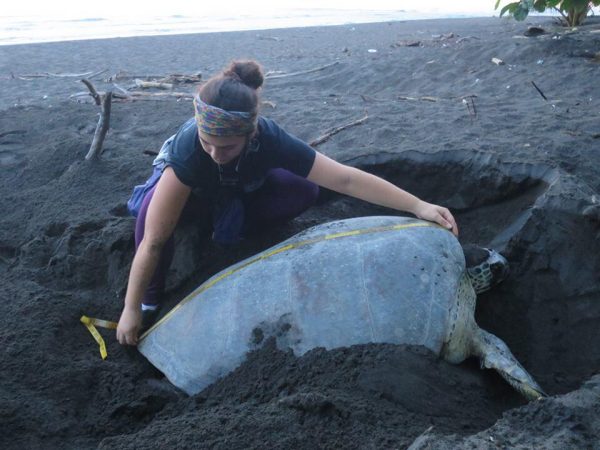
Learn more about the Kontiki project here: https://www.youtube.com/watch?v=BM0tbA5k5a4
And follow STC Tortuguero on Facebook: https://www.facebook.com/SeaTurtleConservancyTortuguero/?fref=ts
The Randgaard family has been engaged actively in fundraising at STC since 2013, when they established The Lisa Jo Randgaard Fund to honor their beloved daughter and sister who passed away suddenly at age 43 in May 2012 from complications of her congenital heart condition. It is the first member-initiated endowment fund in STC’s 56-year history. Lisa’s sister, Linda, explains the family’s motivation to focus on fundraising for sea turtles with their handmade soap line, ‘Flippery When Wet.’

Lisa Jo Randgaard
Q: Why did you decide to make soaps to benefit your sister’s named endowment fund?
A: Lisa was a devoted animal activist, especially when it came to endangered sea turtles, and she was a creative artist. Soaps were one of her favorite things to make for family and friends. Mom, Diane and I decided this was a fitting way to generate funds for a cause so very near and dear to Lisa’s heart. Our family covers all costs to make and ship our Flippery When Wet soaps, ensuring that 100% of all donations go to Lisa’s Fund.
Q: How did it go the first year?
A: Beyond our expectations! Over 400 soap bars have shipped since we launched the soap line last year, and we hope for another great holiday season to help us exceed $70,000 in principal gifts to Lisa’s Fund. Since it is an endowment fund, these wonderful donations will continue to support sea turtles in perpetuity.

Flippery When Wet soap bars come in Citrus, Lavender-Litsea, Lemongrass, Rosemary-Mint and our newest arrival – Sea Clay!
Q: What kind of soaps do you make?
A: Lisa’s sister, Diane, is our soap maker and each small batch of soap makes 32 unique bars. The process from batching to shipping takes a total of four weeks, including curing time. She uses only pure essential oils (not artificial fragrances) along with sustainable palm oil, organic coconut oil and other nourishing skin oils. We never use animal products in any of our soaps since animal protection is our priority. With a minimum donation of $45 for 4 bars that includes shipping and handling, people can choose from Citrus, Lavender-Litsea, Lemongrass, Rosemary-Mint and our brand new Sea Clay! The soaps are very gentle on the skin and the oils create an amazing aromatherapy experience for users.
Q: How can people get your soaps?
A: Visit LoveIntoSustainedAction.com, our family’s website devoted to fundraising for Lisa’s Fund. Donors will be directed to STC’s website to make their donation to The Lisa Jo Randgaard Fund; they will then complete our online order form to select their soap bars, both quantity and scents. We have had people make gifts for up to 20 bars of our soap. The generosity from across the country has been very comforting and uplifting to our family since we chose to direct our grief into something positive. This holiday, we hope to raise $2,000 or more by January 1, 2016.
Q: Is there a deadline if people want to give your soaps as holiday gifts?
A: Soaps take two weeks to ship and we encourage people to order as soon as possible to ensure that they receive them in time for holiday giving. Shipping and handling are included in the donation levels outlined on our website. Holiday orders should be received by Friday, December 11. On behalf of my family and me, I would like to extend deep gratitude for the extraordinary support we have received from the Sea Turtle Conservancy Community. Your hearts are as big as the ocean, and we are humbled by your kindness.

Jenny, Linda holding Carmen, Tom, Diane & Jerry Randgaard
The holidays are near, which means it’s time to celebrate generosity and give! On December 1, 2015 Sea Turtle Conservancy (STC) will be participating for a third time in #GivingTuesday. #GivingTuesday provides one day to make a BIG difference!
STC needs your help on this special day to support the Barrier Island Center (BIC)! The BIC, located in Melbourne, FL in the heart of the Archie Carr National Wildlife Refuge, is an education and outreach center which provides free or low-cost programs to visitors, local schools and community members.
These programs help to educate the public about the important eco-systems of the barrier island, wetlands, and lagoon. These areas provide vital nesting and foraging habitat for sea turtles. Since the BIC opened in 2008 over 245,000 adults and children have been able to learn through hands-on activities such as Eco-Explorers summer camps, oyster mat making, sand dune planting, and much more.
Unfortunately, the BIC recently learned it would not be receiving an annual grant of $15,000 to help fund education programs and other operating costs.
Join the movement and help STC continue it’s efforts to further these educational programs.
Can we count you in for #GivingTuesday? Help us reach our $15,000 goal! Click here to participate!
Since 2000, when Sea Turtle Conservancy waged a successful campaign to block a proposal by the Cuban government to reopen international trade of sea turtle products, STC has been trying to build collaborative relationships with Cuban sea turtle researchers. For example, STC facilitated the participation of two Cuban biologists in the International Sea Turtle Symposium. We included several young Cuban biologists as turtle Research Assistants in Tortuguero, Costa Rica, where they gained valuable field experience. And in Bermuda, a biology student from Cuba was sponsored to participate in a course offered by STC and our partners that teaches in-water techniques for studying sea turtles. Despite these efforts to build relations in Cuba, STC’s ability to directly participation in turtle research or conservation in Cuba has been stymied by longstanding restrictions against American travel to the country…until now.
 As widely reported in the news, President Obama recently took steps to improve diplomatic relations with Cuba. The U.S. Embassy in Havana has reopened, and the State Department announced new guidelines making it easier for American citizens to travel to Cuba by participating in authorized “People to People” programs. Immediately following this announcement, STC partnered with the Ocean Foundation and Holbrook Travel to organize a turtle research and cultural exchange expedition to Cuba that would meet the new qualifications and allow STC to explore opportunities for collaborating with sea turtle researchers in one of Cuba’s most pristine national parks. Once our trip was approved by the State Department, STC officially opened registration to members and supporters, and all 20 spaces were filled rapidly.
As widely reported in the news, President Obama recently took steps to improve diplomatic relations with Cuba. The U.S. Embassy in Havana has reopened, and the State Department announced new guidelines making it easier for American citizens to travel to Cuba by participating in authorized “People to People” programs. Immediately following this announcement, STC partnered with the Ocean Foundation and Holbrook Travel to organize a turtle research and cultural exchange expedition to Cuba that would meet the new qualifications and allow STC to explore opportunities for collaborating with sea turtle researchers in one of Cuba’s most pristine national parks. Once our trip was approved by the State Department, STC officially opened registration to members and supporters, and all 20 spaces were filled rapidly.
STC’s first expedition to Cuba took place over eight days in September. Leading the expedition were STC Executive Director David Godfrey and Scientific Director Dr. Emma Harrison. Also participating in the trip were an enthusiastic mix of STC donors, Florida turtle volunteers, scuba divers from around the US and even the UK, an architect, and even a turtle conservationist from Hawaii. During our journey through Cuba we interacted with the amazing and friendly people of Cuba; discovered a diverse and rapidly-changing culture; explored pristine natural resources; marveled at cities, cars and architecture preserved for a generation; learned about an explosion of urban-based organic farming; and, of course, observed a unique population of sea turtles nesting on Cuba’s far western shore. To say the trip was amazing is an understatement; it was unforgettable.

The organic farm where we learned about sustainable urban agricultural.
Cuba hosts regionally-important nesting populations of hawksbills and green turtles. In addition, many nesting beaches and marine habitats around Cuba are in near-pristine condition and are ripe for long-term sea turtle research and recovery. During the course of the expedition, STC forged a strong new relationship with Cuban biologist Dr. Julia Azanza, who leads the turtle research project at Guanahacabibes National Park. Based on our interactions with Dr. Azanza, STC hopes to achieve a new era of support for sea turtle conservation in Cuba. Plans already are in the works for a return trip in 2016, when we hope to assist in the deployment of satellite transmitters on several nesting green turtles. Anyone interested in joining the 2016 expedition should contact David Godfrey at david@conserveturtles.org to inquire about reserving a spot. Like this year’s expedition, spaces will fill up quickly.
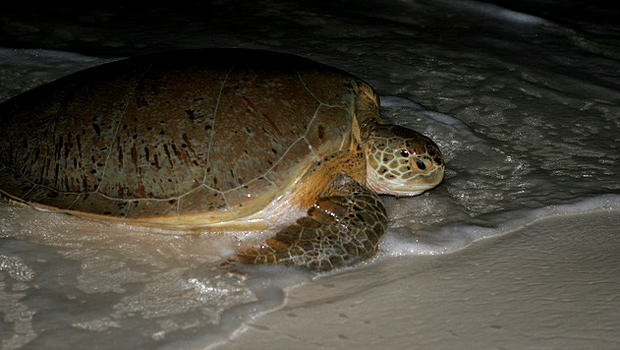
Cuba Expedition Travel Journal by Dr. Emma Harrison
STC was met at the Havana airport by a dedicated local guide and bus driver, who remained with our group throughout the 8-day expedition. Our assigned guide was the lovely and knowledgeable local guide, Susana Rodriguez, who STC hopes to book for future visits. For the first couple of nights our base was the iconic Hotel Nacional de Cuba, which overlooks the ‘Malacón’ – the iconic waterfront walkway that is a popular hangout for local residents. Our diverse program of activities commenced with a guided tour of an organic farm, where we learned about sustainable urban agricultural that is blossoming in suburbs of Havana and other cities around Cuba. Lunch on our first full day was at a family-run ‘paladar’ in Cojima and included a variety of traditional dishes, Cuban coffee, of course, and mojitos! Most businesses in Cuba are owned and operated by the government. However, over the last year restrictions have eased in the operation of private restaurants, or “paladars,” which tend to have a much higher variety and quality of food.
 The main reason for STC’s trip was to visit and provide assistance to the sea turtle project run by Cuban biologist Dr. Julia Azanza, with the long-term goal of developing a partnership through which STC can support sea turtle research and recovery in Cuba. Dr. Azansa joined our group in Havana to give a thorough presentation about her work and the current status of turtle conservation in Cuba.
The main reason for STC’s trip was to visit and provide assistance to the sea turtle project run by Cuban biologist Dr. Julia Azanza, with the long-term goal of developing a partnership through which STC can support sea turtle research and recovery in Cuba. Dr. Azansa joined our group in Havana to give a thorough presentation about her work and the current status of turtle conservation in Cuba.
After our brief exploration of Havana we boarded our bus and began a rather eventful journey to Guanahacabibes National Park in the westernmost part of the island. Less than half way to our destination we unfortunately blew a tire, and had to creep slowly several miles to the Cuban equivalent of a rest area. We only had to wait an hour or so before a replacement bus picked us up and we were able to finish the remainder of our journey. Our trusty bus driver, Juan Carlos, however, had to wait another 5 hours before he was able to fix the tire and make his way to the hotel with our assigned bus.
The following morning we got our first look at the nesting beach in Guanahacabibes, which resembled a lunar landscape due to all of the deep body pits characteristic of the green turtles—the main species nesting in this part of Cuba. Dr. Azanza introduced us to the student volunteers who live in rustic conditions (in tents, with no electricity or running water!) for several weeks at a time while they conduct track surveys and night patrols to collect valuable scientific data for the p about the green turtles nesting at this site. We learned that a green turtle nest had hatched the previous night and were able to participate in a nest excavation to assess hatching success. Fortunately, the majority of hatchlings had made it safely from the nest to the ocean.

Observing a nest excavation on the beach
Cuba’s marine environment is very pristine, as we witnessed first-hand during snorkel trips to coral reefs that were just offshore from our hotel in Maria la Gorda. While we didn’t happen to see any turtles while in the water, we did enjoy crystal clear blue water, beautiful reefs and a fantastic diversity of fish species.
During our evenings of turtle patrolling we were fortunate enough to encounter a green turtle that came ashore to lay her eggs during the two nights we were on the beach. We also had the great fortune of observing the emergence of a nest of green turtle hatchlings! For some in our group this was the first time that they had seen either baby turtles or a nesting female, and to have that first up-close and personal experience on a remote beach in a Cuban National Park made it all the more memorable for everyone, even for those of us who have seen it innumerable times before.
Among the other highlights of our trip was a visit to a tobacco farmer in the agricultural region of Viñales—a dramatic and lush valley in Cuba’s interior that produces tobacco for some of Cuba’s most famous cigar brands. Sitting in the farmer’s kitchen and watching him expertly roll a cigar using tobacco grown in the surrounding fields was another unique experience. Most in the group could not pass up the opportunity to sample a hand-rolled Cuban cigar made directly at the source.
 An unexpected change of hotel meant that we got to spend a night in Pinar del Río, on the very day when the region was celebrating its 128th anniversary! Our unplanned change in itinerary turned into an amazing opportunity to watch a street parade and meet numerous local characters who were thrilled to find a group of American’s staying in their village. In fact, it was common throughout our travels around Cuba to encounter people who were genuinely overjoyed to meet Americans. To a person, everyone we met in Cuba was incredibly friendly and helpful.
An unexpected change of hotel meant that we got to spend a night in Pinar del Río, on the very day when the region was celebrating its 128th anniversary! Our unplanned change in itinerary turned into an amazing opportunity to watch a street parade and meet numerous local characters who were thrilled to find a group of American’s staying in their village. In fact, it was common throughout our travels around Cuba to encounter people who were genuinely overjoyed to meet Americans. To a person, everyone we met in Cuba was incredibly friendly and helpful.
The days passed quickly and all too soon we found ourselves heading back to Havana for our last night in Cuba, but not before one last whirlwind of cultural experiences. The STC group spent half a day exploring Ernest Hemingway’s farm, Finca La Vigia, which has been miraculously preserved by the Cuban people and is still filled with Hemingway’s personal possessions, clothes, artwork, book, and even his famed boat “Pilar.” Later that night our group was taken to see the famous Opera de la Calle, a talented company of Cuban singers, dancers and musicians that treated STC to a private performance none in our group will ever forget.
Of course, no trip to Cuba would be complete without a little drama, and ours came in the form of multiple power outages as we were waiting in line to go through immigration to leave the country. Each time the power went out the computer system had to be reset, eating up valuable time when we should have all been heading to the gate! Gradually, at less than a turtle’s pace, each member of our group managed to make it through and we all boarded the plane, with just minutes to spare before takeoff. Of course, we learned later that this is a common occurrence and the American Airlines flight crew knows to wait for all passengers to clear security during such delays.
This was definitely a memorable trip for everyone, and one that STC will be repeating in the future. We are excited about the possibility of forging a collaborative relationship with sea turtle conservationists in Cuba, to give our members an opportunity to visit this incredible country and support a local project working to protect the region’s turtle populations!
Plastics have become a staple of modern societies across the globe. In 2012, nearly 300 million tons of new plastic items were produced. Each day, these and other plastic articles are sold, used, and disposed. However, an alarming amount of these plastics do not stay on land. Through improper disposal or direct dumping, millions of tons of plastic now call our ocean home.
According to recent studies, including a paper in the prestigious journal Science, we are facing a dire future:
As organizations committed to ocean and human health, the mounting body of science makes us increasingly concerned about the growing tide of plastics entering the ocean and its negative impacts on marine wildlife and habitats.
We’re calling on industry to work with us to stop plastic from entering the ocean.
The signees of this letter represent a diverse array of NGO stakeholders from around the world asking industry and fellow NGOs to stand by us to help stop plastics from entering the ocean. By working together, we can develop innovative solutions, including integrated waste management, at a global scale that will reduce plastic leakage from land and keep our ocean and communities vibrant and healthy.
Please join us.

If you would like to add your organization as a signatory, please email: plasticpreventionletter@gmail.com
Learn more at http://www.plasticpreventionletter.org/
Sea Turtle Conservancy (STC) would like to give a special congratulations to the winners of our 2016 Sea Turtle Scenes Calendar Contest! All of the photos were truly phenomenal. Thank you to everyone who took the time to enter!
The winning photographs will be featured in STC’s 2016 Sea Turtle Scenes Calendar, which will be available online in our gift shop in November—just in time for the holidays! Thank you to all of our participants who made this year’s selection exciting and especially difficult. If you missed out on this one, look out for the 2017 photography contest next summer!
Here are the winners:
COVER PHOTO
By: Kevin Pursley
Green turtles in formation, Cliff Bonaire

JANUARY
By: Angelica Arroyo
Olive Ridley hatchling, Tierra Colorada, Guerrero
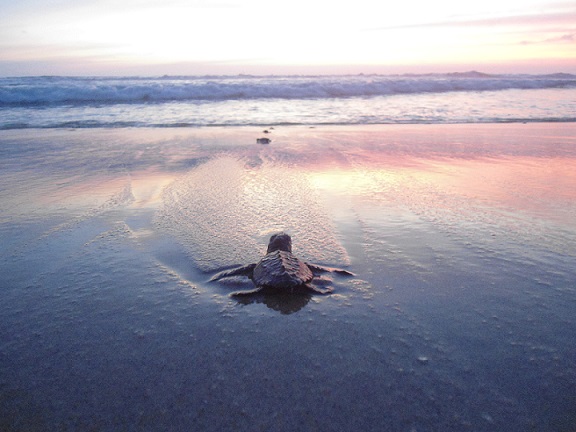
FEBRUARY
By: Karla Morales
Leatherback sea turtle, Dorado, Puerto Rico
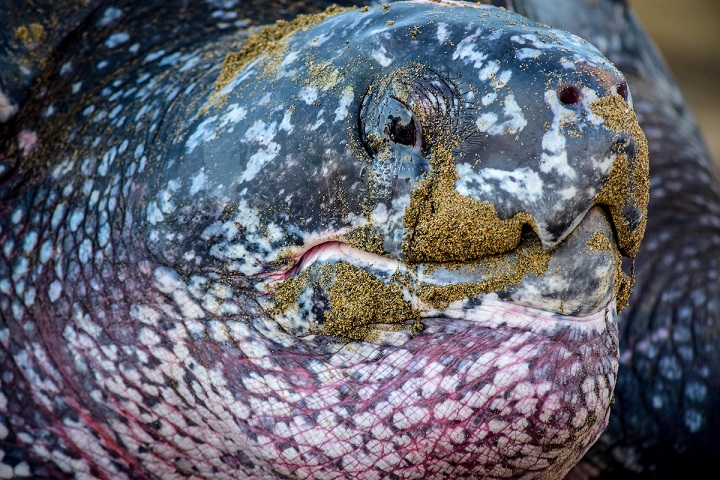
MARCH
By: Ben Hicks
Green sea turtle, Boca Raton, Florida
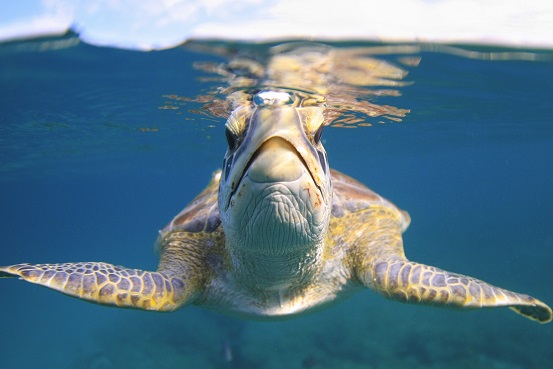
APRIL
By: Adhith Swaminathan
Leatherback hatchling, Andaman & Nicobar Islands, India

MAY
By: Adhith Swaminathan
Olive Ridley, Rushikulya, Orissa, India

JUNE
By: Julie Suess
Hawksbill sea turtle, Turks & Caicos

JULY
By: Vince Lamb
Green sea turtle, Melbourne Beach, Florida

AUGUST
By: Karla Georgina Barrientos Munoz
Hawksbill hatchling, Mona Island, Puerto Rico

SEPTEMBER
By: Karla Georgina Barrientos Munoz
Olive Ridley, Nancite Beach, Costa Rica

OCTOBER
By: Ursula Dubrick
Leatherback hatchling, Melbourne Beach, Florida

NOVEMBER
By: Ben Hicks
Green sea turtle, Boca Raton, Florida
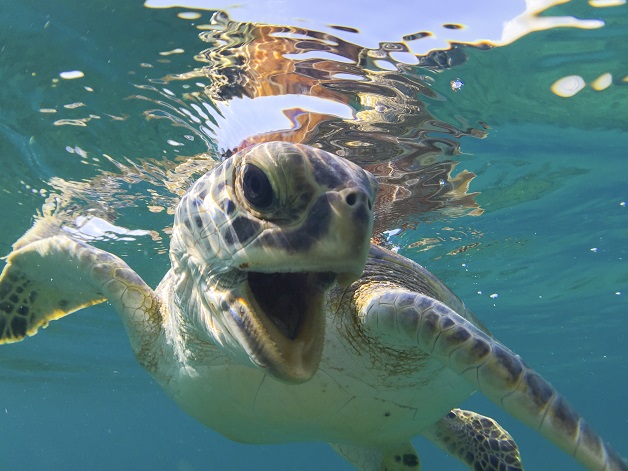
DECEMBER
By: Karla Morales
Leatherback sea turtle, Dorado, Puerto Rico

Sea Turtle Conservancy celebrated its 8th annual Tour de Turtles (TdT) with a live sea turtle release on August 2nd at the Barrier Island Center, located in the heart of the Archie Carr National Wildlife Refuge in Melbourne, Florida.
Hundreds of people gathered to watch STC researchers release two adult female loggerheads sea turtles, named “Myrtle” and “Dash”, into the ocean to begin their migrations. Myrtle was named by her sponsors at Ripley’s Aquariums and Dash was named by her sponsors at Shark Reed Aquarium. The event was sponsored in part by the Florida Sea Turtle License Plate.

This year 13 sea turtles, representing four different species, were swimming in the race to conduct valuable research and raise public awareness about sea turtles.
The 2015 TdT included live turtle releases in Panama, Costa Rica, Nevis and Florida. This year is the first time a nesting turtle was released from Florida’s West Coast. Loggerhead “Amie” was named by her sponsors from the Anna Maria Island Turtle Watch group and released in the Gulf of Mexico in June.
Before each turtle release, STC scientists attached a satellite transmitter to its shell using– safe epoxy or fiber class resin. The transmitter allows STC and the public to track the turtles as they travel and migrate from their nesting beaches to their foraging grounds.
Meet the competitors!
Calypso Blue IV, Leatherback
Sponsor: Atlantis Paradise Island
Cause: Commercial Trawl Fisheries
Myrtle, Loggerhead
Sponsor: Ripley’s Aquariums
Cause: Plastic Debris
Marina, Loggerhead
Sponsor: Disney Conservation Fund
Cause: Plastic Debris
Susie Q, Green Turtle
Sponsor: Turtle & Hughes, Inc.
Cause: Light Pollution
Dash, Loggerhead
Sponsor: Shark Reef
Cause: Commercial Longline Fisheries
Tinkerbell, Loggerhead
Sponsors: Disney’s Animal Protection Programs & Disney’s Vero Beach Resort
Cause: Water Quality
Millie, Hawksbill
Sponsor: Four Seasons
Cause: Water Quality
Insolites, Leatherback 
Sponsor: Continents Insolites SAS
Cause: Invasive Species Predation
Pawikan, Green Turtle
Sponsor: Pacsafe
Cause: Egg Harvest for Consumption
Luna, Hawksill
Sponsor: Four Seasons
Cause: Climate Change
Tiki, Hawksbill
Sponsors: Treadright Foundation & Contiki
Cause: Illegal Shell Trading
Aaron, Loggerhead
Sponsor: The Turtle Hospital
Cause: Boat Strikes
Amie, Loggerhead
Sponsor: Anna Maria Island
Cause: Beach Erosion
Turtle fans can follow the turtle’s migration online at www.tourdeturtles.org, and cheer on their favorite competitor while learning the threats that sea turtle face. Fans can support their favorite turtle online by virtual adopting, tweeting, or making a pledge for every mile the turtle swims. The turtle who swims the farthest by October 31 will be crowned the winner of the “race”. while the turtle who raises the mist support online, will be crowned the “People’s choice winner”.
Kirsty, a juvenile green turtle tracked by satellite as part of the collaborative Bermuda Turtle Project (BTP), has flown the coop! After being fitted with a satellite transmitter and released in Bermuda in August 2014, Kirsty’s movements and habitat use were carefully tracked by BTP researchers Drs. Anne and Peter Meylan and Robert Hardy, with scores of STC members and supporters following the turtle’s movements online.

Kirsty, a juvenile green sea turtle being tracked by satellite as part of the Bermuda Turtle Project (BTP)
For months, the young turtle shuttled between positions in the nearshore sea grass beds of Somerset Long Bay, where it was originally tagged, and two locations located on the west side of the Bermuda Platform. But then Kirsty did something exciting!
STC and its BTP partners learned decades ago that Bermuda’s near-shore waters provide important developmental habitat for green turtles that originate from all over the Caribbean and Atlantic. No regular nesting of green turtles occurs anymore in Bermuda, yet its waters are filled with thousands of young green turtles that arrive when they are roughly the size of a Frisbee and leave the island shortly before reaching full adulthood.
When and how they leave Bermuda, and where they go, are important mysteries in the life cycle of green turtles. In an attempt to answer these questions, STC and its partners use satellite transmitters to track some of the larger green turtles captured each year as part of the in-water monitoring program.
On June 2, 2015, with researchers watching closely, Kirsty left the Bermuda Platform and began a long migration toward what will become her adult foraging grounds. Unfortunately, Kirsty’s transmitter quit sending signals just a week into her migration, though she appeared to be headed toward known foraging grounds off the south Florida coast.
Kirsty was a big turtle (66.7 cm “Straight Carapace Length”) when measured last August, so it was not entirely unexpected that she might soon leave Bermuda. However, with scores of turtles having been tracked in Bermuda, only one other green turtle was observed by BTP researchers leaving the island.
“It was very exciting to track the start of Kirsty’s important habitat transition,” said STC Executive Director David Godfrey, “but for now her ultimate destination will remain a mystery.”
The BTP was initiated in 1968 by former STC Board Member Dr. H. Clay Frick II, in cooperation with the Bermuda Government. Since 1991, the project has been a collaborative effort of STC, the Bermuda Aquarium and Zoological Society and Drs. Peter and Anne Meylan. The research efforts of the BTP Project are focused on filling in the information gaps on green turtle biology so that successful protection may be given to these amazing animals.
In addition to annual research, every year since 1996 the BTP has offered an international in-water course on sea turtle biology and conservation. It brings students and scientists from around the world to Bermuda to study the pelagic and juvenile phases of the marine turtle life cycle, turtle biology and conservation through observation of the animals in their marine habitat, necropsies, and a capture-tag-release study.
This year’s course, to be held in August, will be led in part by STC Scientific Director Dr. Emma Harrison. This summer, STC also will host a group of Board members and donors on an exploratory trip to observe and participate in the Bermuda turtle research program.